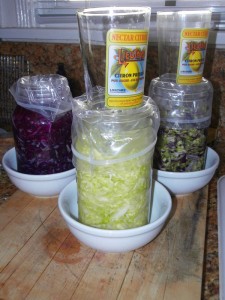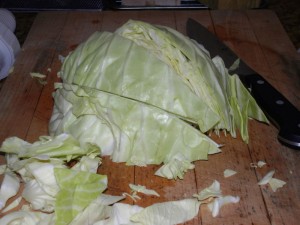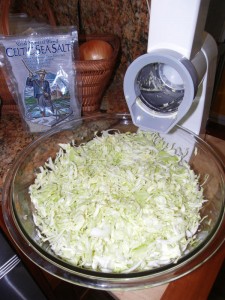 The picture here shows three kinds of sauerkraut all packed into their glass jars, ready to start their alchemical advanture. In a couple of weeks, the contents of each jar will be magically transformed from wet, salty cabbage into a crunchy condiment with complex layers of nuanced flavor – and with far more nutrients than the original vegetable had on its own.
The picture here shows three kinds of sauerkraut all packed into their glass jars, ready to start their alchemical advanture. In a couple of weeks, the contents of each jar will be magically transformed from wet, salty cabbage into a crunchy condiment with complex layers of nuanced flavor – and with far more nutrients than the original vegetable had on its own.
When the Chinese were building The Great Wall, starting during the Qin dynasty (back in the 4th century), fermented cabbage was a staple food. Those workers knew a thing or two about staying healthy during the harsh winter months – who am I to argue with them?
Virtually every traditional culture has some kind of fermented vegetable; many have fermented fruits, and a number have fermented animal foods (typically meat, fish, or dairy). From sauerkraut to kimchi, from chutney to garum*, from hakarl* to kefir, our ancestors have been fermenting for thousands of years. Ferments have enabled people to “stretch the harvest” for all those years when we as humans lacked refrigeration (other than those in snowy climes). For instance, dairy animals keep producing milk even when a family may have had enough to drink (along with the calf whose birth caused the milk to be produced in the first place). Butter, kefir (and other fermented milks like fjilmolk, piima, buttermilk), and, of course, cheese, are all wonderful ways to not only avoid wasting fresh milk, but to make some incredibly delicious foods.
In addition to the rather amazing range of flavors available once foods have been fermented, they also offer our bodies a host of gut-friendly bacteria and enzymes to enhance our digestion and, as a result, our health.
Did you know that a substantial amount of our overall immunity originates in our guts? The lowest estimate I’ve seen is 80 percent, and it goes up from there. That means that the healthier and happier our digestive system is, the healthier and (with any luck) happier we are, too. What wipes out the good guys is the topic of a whole other (future) post, but let’s just say that our current lifestyles, from childhood through adulthood, are replete with foods and pharmaceuticals that are pretty much guaranteed to hinder the function of our gut bacteria.
We just plain owe it to ourselves to give our bodies, and our digestive tracts, a chance to do their jobs well – don’t you think so? So a really simple way to start enhancing things is with your very own homemade sauerkraut. It’s cheap, it’s so easy that you won’t believe it, and the opportunities to change it up and make a variety of “house versions” are nearly endless.
What follows is a general guideline for making sauerkraut, along with suggestions for ways to spice things up if you are so inclined. The description is going to take you longer to read than your first batch will take to make, that’s how easy it is. So go to the farmer’s market, the natural foods store, or other source for fresh organic cabbage. Buy one. Then set aside an hour to make some glorious sauerkraut!
Sauerkraut
Makes about 1 quart, maybe a little more or less depending on your cabbage
Ingredients
1 medium to large organic green cabbage (about 8-9 inches in diameter), or a couple of small ones
Celtic sea salt or Himalayan crystal salt
Optional: Caraway or fennel seeds; bay leaves; dried chiles; carrots; onions
Equipment
- Something to shred the cabbage – this could be a grinder with a shredding attachment like the one pictured here, or a food processor, or a German cabbage grater, or even a sharp knife and a cutting board and patience
- A sharp chef’s knife and a cutting board
- A large bowl to hold your shredded cabbage before you pound it
- 1 quart-sized glass mason jar and lid (preferably wide mouth, but narrow will do)
- A deep-sided metal bowl to pound your cabbage in
- Something to pound the cabbage – a meat pounder, a rolling pin (the one that’s just a large cylinder, not one with handles), or a long, sturdy pestle
- A clean dish towel to set the pounding bowl on
- A canning funnel
- A shallow bowl or dish just big enough to set the mason jar in
- A quart-sized plastic bag
- A weight – this could be a glass that fits inside the mouth of the jar, or a clean, smooth stone, or even dried beans
Method
I’m going to describe and provide photos for shredding cabbage using the Jupiter grain mill. I’ve had it for years, and just love it. It has a grain grinding attachment that works like a charm, as well as various shredding attachments, and a meat grinding attachment. (I haven’t gotten around to getting the flaker attachment yet, but it makes rolled oats out of whole oat groats.) But if you’re shredding with another technique, you’ll still follow many of the same steps; I’ll do my best to point out where you’ll need to change things a bit.
If there are any yellowed, funky looking leaves on the cabbage, pull them off and discard. Lightly rinse and dry on a clean towel. Cut in half, down through the stem, then cut out the core (it won’t hurt anything, but it’s more solid than the leaves so will take longer to break down; I recommend adding it to the compost pile).
 Put each half, cut side down, on your cutting board. Cut each half in half, and then each quarter in half again; you’ll end up with 8 wedges. To make it easier to feed the cabbage into the shredder, or through the feed tube of your processor, cut each wedge in half again at an angle.
Put each half, cut side down, on your cutting board. Cut each half in half, and then each quarter in half again; you’ll end up with 8 wedges. To make it easier to feed the cabbage into the shredder, or through the feed tube of your processor, cut each wedge in half again at an angle.
 If you’re using the grating board, which is a special tool traditional in Germany (where kraut is practically an institution), you won’t want to take the last step. You may not even need to wedge it. See what works best for you and your personal style.
If you’re using the grating board, which is a special tool traditional in Germany (where kraut is practically an institution), you won’t want to take the last step. You may not even need to wedge it. See what works best for you and your personal style.
If you’re cutting by hand, just take it from the original 8-wedge stage and keep cutting crossways into as thin slices as you can without a) making yourself nuts and/or b) cutting yourself.
Go ahead and shred all the cabbage, and collect it in a large bowl. Every so often, sprinkle on some sea salt. I don’t measure, and I don’t recommend that you do, either. You’ll end up using somewhere between 2-3 teaspoons total. (If you’re nervous about this stuff, just measure out a tablespoon of salt into a little dish, and sprinkle as you go till it’s all used up by the time the bowl is full of freshly shredded cabbage.)
 It never ceases to amaze me how much shredded cabbage fluffs up, nor now much it packs down after salting and pounding! Here’s a photo of a 4-quart glass bowl full of the results of shredding one head of cabbage.
It never ceases to amaze me how much shredded cabbage fluffs up, nor now much it packs down after salting and pounding! Here’s a photo of a 4-quart glass bowl full of the results of shredding one head of cabbage.
OK, you’re almost there. What happens now is that you are going to pound the cabbage a little at a time to break down some of the structural cellulose, which will release some of the water in the cabbage, and allowing the fermentation process to get going.
 Put a couple of handfuls of the salty cabbage into your pounding bowl. Sit on a sturdy kitchen chair, put a folded towel between your knees on the seat, and put the bowl on the towel (if you want to hear something that sounds like the walls caving in, try this without the towel). Take your pounding implement and come straight down on the cabbage. You’re not trying to kill it, you’re just pummeling it a bit, so you don’t have to use a lot of force. The main thing is that you want to have smushed, with some energy, every shred of cabbage in the bowl. My routine goes something like, pound, pound, push cabbage down the sides back into the middle, pound, pound, push it back, and so on. I might end up pounding it a dozen times at the most. You’ll know it’s time to stop when it looks rather wet and shiny.
Put a couple of handfuls of the salty cabbage into your pounding bowl. Sit on a sturdy kitchen chair, put a folded towel between your knees on the seat, and put the bowl on the towel (if you want to hear something that sounds like the walls caving in, try this without the towel). Take your pounding implement and come straight down on the cabbage. You’re not trying to kill it, you’re just pummeling it a bit, so you don’t have to use a lot of force. The main thing is that you want to have smushed, with some energy, every shred of cabbage in the bowl. My routine goes something like, pound, pound, push cabbage down the sides back into the middle, pound, pound, push it back, and so on. I might end up pounding it a dozen times at the most. You’ll know it’s time to stop when it looks rather wet and shiny.

 Put your canning funnel into the jar opening, and dump the pounded cabbage in. (You’ll have to use your hands or a rubber spatula to help.) Then repeat: pound a couple of handfuls of cabbage, put into the jar. By the time you’ve done this three or four times, the jar will look full. So now you push it firmly down in the jar. You’ll see how much it squishes down, and how much liquid starts to emerge at the same time. It is hard to believe, but just about that whole cabbage will end up in that one quart jar.
Put your canning funnel into the jar opening, and dump the pounded cabbage in. (You’ll have to use your hands or a rubber spatula to help.) Then repeat: pound a couple of handfuls of cabbage, put into the jar. By the time you’ve done this three or four times, the jar will look full. So now you push it firmly down in the jar. You’ll see how much it squishes down, and how much liquid starts to emerge at the same time. It is hard to believe, but just about that whole cabbage will end up in that one quart jar.
Continue pounding, filling, and pushing till you’ve got the jar full to within about an inch or a little more from the top. (Any extra cabbage can go into a smaller jar to ferment, or, if it’s just a little, into your next pot of soup or stir-fry.)
All that’s left is to get it ready for the alchemy of fermentation.
 Take a ziplock style bag and push it into the jar. Do your best to spread it out over the surface of the cabbage and up the sides, folding the edges of the bag over the outside of the jar (see photo). Now you want to add a gentle weight, which will keep the fermenting cabbage under the briny liquid you’ve created with all that salt and pounding. A narrow glass works well; just rest it inside the bag. But if you’re working with a narrower jar, or don’t have such a glass, you can use a clean garden stone inside the bag, or fill it with dried beans.
Take a ziplock style bag and push it into the jar. Do your best to spread it out over the surface of the cabbage and up the sides, folding the edges of the bag over the outside of the jar (see photo). Now you want to add a gentle weight, which will keep the fermenting cabbage under the briny liquid you’ve created with all that salt and pounding. A narrow glass works well; just rest it inside the bag. But if you’re working with a narrower jar, or don’t have such a glass, you can use a clean garden stone inside the bag, or fill it with dried beans.
Put the jar someplace where it will stay relatively cool and quiet. My kitchen, which is inside an uninsulated house in Southern California, stays in the 60s for most of the winter, so I can keep jars on the counter. But in summer, I need to use a closet in the bedroom, or a back corner of our garage, to keep it reasonably cool. Wherever you opt to ferment, you want an average temperature of high 40s to low 70s. (If it’s much warmer than that, you need to add more salt at the beginning, like maybe another teaspoon per quart.)
Set the jar in a shallow bowl. When the fermentation gets going in the next few days, the jar will inevitably overflow, and you’ll be happy to have something under it!
Drape a towel or pillowcase over the container to keep light low, and walk away. Check it in a week if the weather is warm, in two weeks if it’s colder. The brighter green of fresh cabbage will have faded to a paler yellow-green. When you take the weight and bag out and take a whiff, it will smell tangy, sour, delicious.
Cap the jar and move to the refrigerator, where it will last for several months. Not that it has much of a chance of going that long, since you want to have something fermented at just about every meal, and since it’s so tasty. But it could last several months and still be good to eat (eventually the flavor will fade, but even then it will not go bad.)
Variations
- Add about a teaspoon of caraway or fennel seeds to the cabbage along with the salt, sprinkling it in as you go. Or add chile flakes to taste, up to a teaspoon per quart.
- Shred other vegetables in along with the cabbage: a peeled carrot or two, a small onion, reed or yellow or white, a few radishes, some daikon. Use your imagination!
- Add some rinsed and shredded sea vegetables, like kombucha or wakame.
Troubleshooting
When you check your jar, particularly in warmer weather, you may see specks of a whitish substance on top of the cabbage. This is a harmless but mildly unpleasant form of yeast (kahm yeast, if you want to know the name) that can form on bits of cabbage that didn’t stay under the brine. Just lift it off with a clean spoon and discard it. I usually gently take off about the top eighth inch of sauerkraut as well, and then the rest of the jar is perfectly fine to eat.
Great resources
Nourishing Traditions, Fallon and Enig, New Trends Publishing
Wild Fermentation, Katz, Chelsea Green
